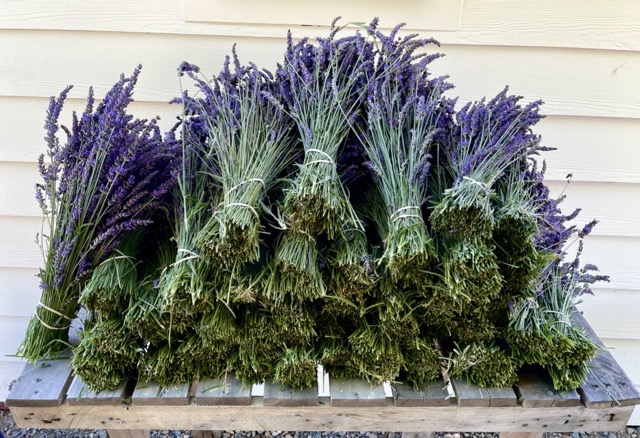Growing lavandula
Introduction to Lavender
Embark on a fragrant journey with our Lavender garden guide. Lavender, renowned for its soothing aroma and lovely purple blooms, is a favorite in gardens worldwide. This guide offers insights into growing and nurturing Lavender, ensuring a delightful display of fragrance and color in your garden.
We have grow lavender in one of our fields for years, and love the views, the pollinator attracting flower spikes and the warm breezes. iin summer that contain the hypnotic scent. Enjoy our growing guide!
Botanical Overview
Understanding Lavender’s Botanical Roots
- Common Name: Lavender
- Scientific Name: Lavandula
- Family: Lamiaceae Originating from the Mediterranean, Lavender is a member of the mint family, known for its aromatic flowers and silvery-green foliage. This perennial herb is not only prized for its beauty and scent but also for its versatility in culinary, therapeutic, and decorative uses.
History and Culture
Lavender’s history is as rich and varied as its fragrance. Tracing back over 2,500 years, it has been revered across many cultures for its medicinal, therapeutic, and religious significance. The ancient Egyptians used Lavender in their mummification process and perfumery. The Romans valued it for its cleansing properties, using it in bathing rituals and to freshen the air. In medieval and Renaissance Europe, Lavender was a staple in herb gardens, not only for its scent and beauty but also for its use in warding off illnesses and as a disinfectant. Lavender’s name is believed to derive from the Latin ‘lavare’, meaning ‘to wash’, a testament to its longstanding association with cleanliness and purification. Over the centuries, its popularity only grew, finding its place in the culinary world, folk remedies, and the flourishing perfume industry of the 19th century. Lavender’s enduring appeal lies in its multifaceted uses, from its calming aroma in aromatherapy to its antiseptic properties, making it a timeless and versatile herb in both historical and modern contexts.
Benefits and Uses
The Multifaceted Appeal of Lavender
- Aromatherapy: Its oil is widely used for its calming and relaxing properties.
- Culinary Uses: Dried flowers can be used to infuse dishes with a delicate flavor.
- Landscape Design: Lavender is ideal for borders, herb gardens, and rock gardens, adding both color and fragrance. Lavender not only beautifies gardens but also offers various uses, from cooking to relaxation techniques.

Varieties of Lavender
Exploring Lavender’s Many Varieties
Dive into the diverse and aromatic world of Lavender with this exploration of its various species. Each variety of Lavender brings its unique charm and characteristics, making them suitable for different climates, uses, and aesthetic preferences. From the classic English Lavender, beloved for its sweet fragrance and culinary applications, to the striking Spanish Lavender with its distinctive blooms, the Lavender family offers a delightful array of choices. Lavandin hybrids are known for their robust growth and high oil content, ideal for crafts and aromatic products, while French Lavender, with its finer foliage, adds a delicate touch to gardens. Understanding the nuances of each variety can help gardeners choose the perfect Lavender to suit their needs, whether for ornamental beauty, aromatic oils, or culinary delights.
- Lavandula angustifolia (English Lavender): Known for its sweet fragrance, ideal for culinary use and oil production.
- Lavandula stoechas (Spanish Lavender): Recognized by its distinct pineapple-shaped blooms and strong scent.
- Lavandula x intermedia (Lavandin): A hybrid variety, known for its long stems and high oil content, perfect for crafting and sachets.
- Lavandula dentata (French Lavender): Features finely toothed leaves and a more subtle fragrance. Each Lavender variety offers unique characteristics, from scent profiles to bloom shapes, catering to different gardening and usage needs.
Planting and Growth Conditions
Creating Ideal Conditions for Lavender Growth
- Sunlight: Lavender thrives in full sun, requiring at least 6-8 hours of direct sunlight daily.
- Soil: Prefers well-draining, sandy or gravelly soil with a neutral to slightly alkaline pH.
- Planting Tips: Best planted in spring or early fall; ensure good air circulation and avoid overcrowding. Proper planting is crucial for Lavender, ensuring a healthy, robust plant.
Care and Maintenance
Maintaining Healthy Lavender Plants
- Watering: Requires minimal watering once established; overwatering can lead to root rot.
- Fertilizing: Generally, Lavender does not require fertilizing; too much can reduce the fragrance.
- Pruning: Prune annually after blooming to maintain shape and promote new growth. Regular care will ensure your Lavender plants remain vibrant and fragrant for years.
Potential Problems
Navigating Common Lavender Challenges
- Pests and Diseases: Watch for fungal diseases like root rot and pests such as aphids and whiteflies.
- Environmental Stress: Lavender is drought-tolerant but can struggle in humid or overly wet conditions.
- Winter Care: In colder zones, provide mulch or cover to protect against harsh winter conditions. Understanding and managing these challenges will keep your Lavender plants healthy and thriving.
Conclusion
Lavender, with its enchanting fragrance and beautiful blooms, is a joy to grow in any garden. By providing the right conditions and care, you can enjoy the myriad benefits of this versatile plant. Whether you’re a seasoned gardener or just starting, Lavender offers a rewarding experience with its delightful presence in the garden.












You must be logged in to post a comment.